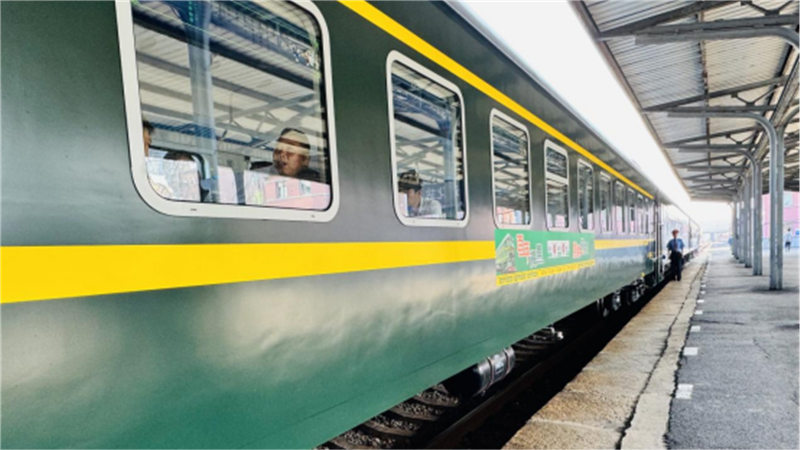Shenzhen to introduce 20 self-driving buses soon, with fare set at 1 yuan

Photo: Official WeChat account of Shenzhen Bus Group
After the recent implementation of driverless ride-hailing vehicles sparked heated discussion, a total of 20 self-driving buses will be put into operation in Shenzhen in South China's Guangdong Province within the year, according to local media reports. Experts told the Global Times on Tuesday that the future of autonomous driving applications still faces many challenges including safety concerns.
Four self-driving bus routes have been currently approved and are expected to officially launch by the end of July, with a fare of 1 yuan ($0.14) for each ride. The routes will cover subway stations, commercial and residential areas, central business districts, industrial parks, and scenic spots.
According to the reports, the driverless buses are equipped with high-definition on-board cameras, millimeter-wave radar, and LiDAR for 360-degree accurate perception of surrounding vehicles, pedestrians, non-motorized vehicles, and changes in road conditions.
The vehicles are also equipped with the country's leading automated driving system, enabling quick judgment and decision-making comparable to an experienced driver. This system allows for precise control of the vehicle, ensuring safe navigation along predetermined routes.
The buses feature an intelligent interactive display screen inside, which provides real-time information on the surrounding traffic participants perceived by the vehicle's sensors, the vehicle's autonomous driving status, and the planned driving route, local media reported.
During the operation, the vehicles can accurately recognize lane markings and traffic lights, perform overtaking maneuvers, and efficiently handle various challenging urban driving scenarios. For instance, it can safely execute unprotected left turns at intersections without traffic lights, navigates intersections with mixed pedestrian and vehicle traffic, identify and yield to vehicles encroaching on the lane and construction areas, give way to pedestrians, and precisely stop at stations.
In Ji'nan, the capital of East China's Shandong Province, the first batch of driverless buses have also started trial operation to collect map data, according to local media reports on Sunday.
Ji'nan has introduced a total of four driverless buses, with the first driverless bus to undertake 240 hours or 1,000 kilometers of on-road testing and other preliminary work after completing the map collection. When the requirements are met, it will enter the demonstration application phase.
On July 3, government departments jointly released a list of pilot areas for the application of the intelligent network integrating intelligent vehicles, smart roads, and real-time cloud technologies, with 20 cities selected, including Jinan and Shenzhen.
Shanghai is also set to begin public testing of autonomous cars as early as next week, offering free rides for residents throughout the trial period.
According to an earlier report, concerns about the safety of autonomous driving have been raised following one of Baidu's autonomous ride-hailing platform Robotaxi's vehicles colliding with a pedestrian on a street in Wuhan. Central China's Hubei Province.
Wu Shuocheng, a veteran automobile industry analyst, told the Global Times on Tuesday that the trend toward automated driving continues to be acceptable, but there may be challenges ahead for large-scale development. It may be used more frequently in some closed and relatively simple route scenarios.
Self-driving technology is undoubtedly becoming more mature, with its iterations happening relatively fast, but the public still has concerns about the level of maturity of this technology, Wu said.
Wu also noted that people have concerns regarding the lack of clarity in assigning responsibility. If no one is sitting behind the wheel, the question of whether the accident was solely due to a communication network problem, a software problem, or an underlying problem with road infrastructure remains unclear.
From a technical perspective, in the absence of vulnerabilities, autonomous driving technology is certainly safer than human driving. However, its greatest risk lies in software control. If the program is maliciously altered, accidents could become more severe, Wu said.
According to the local government in Pingshan district of Shenzhen, the application of the intelligent network integrating intelligent vehicles, smart roads, and real-time cloud technologies, is opening up a new track as many enterprises in the industry chain are pursuing the opportunity, and Shenzhen has nearly 460 intelligent networked automobile-related enterprises, generally forming a comprehensive ecosystem.
However, Wu noted that there is a high cost associated with purchasing and operating autonomous driving applications, with few companies or individuals willing to pay for it, which is also one of the challenges the industry has to face.
Photos
Related Stories
- China's autonomous driving sector ramps up with robust expansion of road testing sweeping
- China's self-driving cars on course for true road readiness
- Workers safeguard Chinese white dolphin habitat during Shenzhen-Zhongshan link construction
- New profession emerges as self-driving industry develops
- Innovative technologies contribute to China's latest mega cross-sea link
- Baidu's robotaxis orders surge, paving way for large-scale autonomous ride-hailing services
Copyright © 2024 People's Daily Online. All Rights Reserved.









